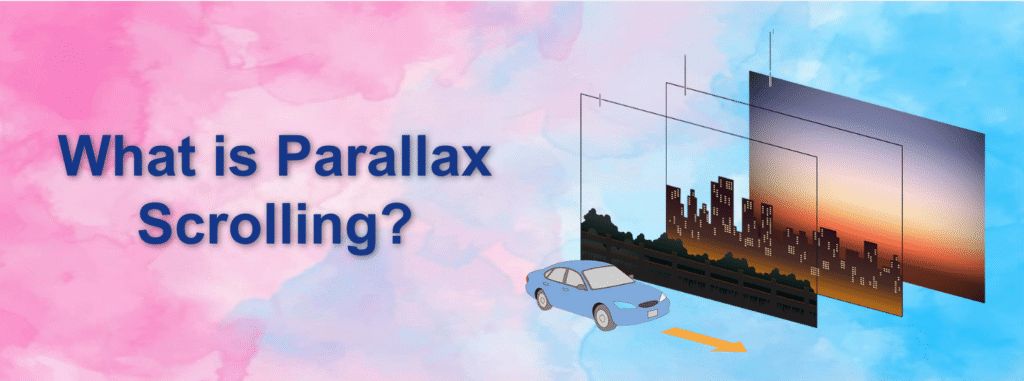What is Parallax Scrolling?

What is Parallax Scrolling?
As people’s attention spans shrink, grabbing users’ interest has become trickier. That’s why using different techniques to keep them engaged is super important. One cool technique is parallax scrolling.
So, what is parallax scrolling? It’s a web design method that boosts user experience. The main idea behind the parallax effect is to create a depth illusion by making the background move slower than the foreground. This difference in scrolling speeds gives a 3D feel in a 2D space.
The parallax effect does a lot of things: it improves user experience, makes scrolling smoother, draws attention to specific parts of a website, helps present content, showcases products or services, and highlights special offers.
Why Use Parallax Scrolling?
Even though parallax isn’t a brand-new idea, it’s still popular because it works well. This technique gives users a smooth scrolling experience, which keeps them engaged with the site and encourages them to explore more content.
But using parallax scrolling can get a bit tricky since several factors affect how well it works. Here are some things to keep in mind:
- If the timing of the layers is off, it can lessen the impact of the parallax effect.
- The website’s loading speed can change how users experience parallax scrolling.
- The effect works best with certain types of content.
- Too many complex animations might frustrate visitors.
- Excessive scrolling can lead to negative experiences.
- Mobile optimization is essential for the effects to work right.
- Some older browsers might not support the parallax effect.
Adding engaging animated elements and effects to your website can be great, but it’s crucial to make sure your content stays accessible. Using anchor links can help users find what they’re looking for without getting distracted by animations.
Types of Parallax Effect
We’ve looked at parallax scrolling before, including its benefits and what can affect how well it works. Now, let’s dive into the different types you’ll commonly see.
Single Page Parallax
Parallax scrolling shines with certain content formats, especially single-page websites and landing pages. Using this effect on multi-page sites can get tricky and mess with the overall design.
Background Parallax Effect
The background parallax effect is one of the most popular uses of parallax scrolling. It usually has a fixed background sitting between two sections of content that becomes visible as you scroll.
Layer Parallax Effect
Layer parallax involves several layers that move in different directions as you scroll down the page. This includes variations like simple parallax with fading effects, zooming in and out, and tilt parallax.
Horizontal Parallax Scrolling
You don’t see horizontal parallax as often as vertical, and it’s generally tougher to pull off. It’s like a slideshow, where the horizontal content animates alongside your scrolling, creating a side-to-side movement.
3D Layer Parallax
Unlike other types where elements move in just two dimensions, this one places elements in a three-dimensional space.
Motion-Sensitive Parallax
This version of parallax responds to mouse movements. Instead of scrolling, the content shifts based on how you move your mouse.
Custom Parallax
In design, there’s always room for creativity! Custom parallax combines different types of effects, adding a unique touch to your website.
These are some of the common types of parallax effects you’ll find online. If you’re not a designer, tackling the more complex effects might be tough, but you can easily play around with simpler ones using online tools.
The Advantages of Parallax Scrolling:
Parallax scrolling is a web design technique that has a lot going for it, which is why it’s so popular. If you’re thinking about using parallax design for your site, these benefits might just convince you to jump on board.
Improved Storytelling
One of the coolest things about parallax design is how it boosts storytelling. It lets you weave a narrative into an otherwise simple website layout. With parallax scrolling, you can add layers, intricate details, and depth to your design, making your message clearer. These kinds of websites create a smooth browsing experience that keeps visitors engaged and wanting to scroll more.
Increased Micro interactions
What makes parallax scrolling really charming is how it encourages small interactions between users and the site—something static designs often miss. You might see color changes when you hover over certain sections or notice a cursor change when it’s over text. These little touches create a connection between the user and the website, making it feel livelier and more responsive.
Focused Attention
Besides being fun, parallax scrolling can also help direct viewers’ attention to important parts of a website, like call-to-action buttons, email sign-up forms, and contact info. While static designs let users roam freely, parallax sites unveil information step by step, guiding visitors through the content.
Extended Session Durations All these advantages lead to a better user experience, which means people stick around longer on your site. Longer session durations are crucial because Google and other search engines consider them when ranking websites in search

